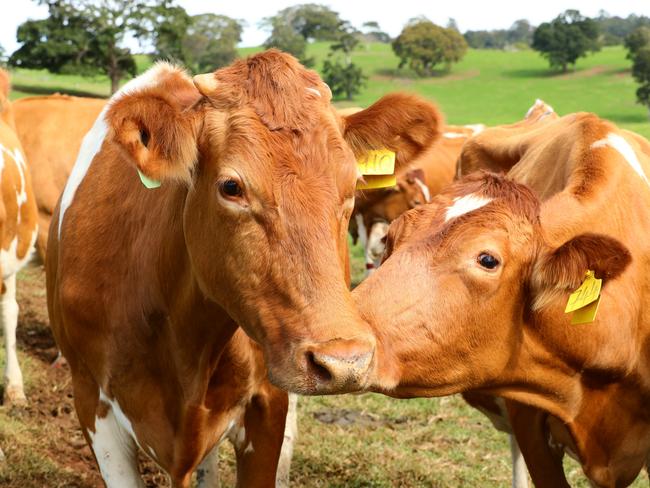Sydney 2050: How we’ll live, eat and work revealed
From driverless cars to a CBD suburbia and self-healing buildings: Experts have predicted how Sydneysiders will live in 2050.
Central Sydney
Don't miss out on the headlines from Central Sydney. Followed categories will be added to My News.
Last year proved that nobody can really predict what the future holds.
From social isolation, to normalised mask wearing, hard borders and working from home.
Nothing is certain.
But experts believe predictions can and should be made into how we will live in the future.
“Things like COVID can change everything so quickly and can’t be predicted,” leading social researcher Mark McCrindle said.
“But on the other side, COVID has shown how we as humans like rhythms, need patterns and social mores. We need to know what the expectations are.”
He added: “2050 will look quite different but it will certainly be recognisable because it will be a human future, even though technology will be at the forefront.”

In 2050, Generation Alpha – the generation which began the same year as Instagram launched – will be making the big decisions for Sydney and beyond.
The world’s population will have hit about 9.7 billion and Sydney will have grown to about 8 million.
Right now experts are planning for the Sydney of 2050 and they’re pretty optimistic about it.
No mentions of robot dystopias or technology gone rogue.
Here’s how the experts predict we will live in 2050.
FOOD
In 2050 we may have a piece of meat on our plate that doesn’t look like any cut we eat today.
That’s because our meat would most likely have been cultivated from the cells of an animal, rather than the animal itself.
“Cellular agriculture is the idea of moving away from whole organisms to microscopic organisms,” UNSW Chemical Engineering Professor Johannes le Coutre explained.
“It’s a situation where you can produce and grow edible materials from a cellular level.
“It is meat produced without the animal.
“Now if it looks like a steak cut or not, is simply a homage to the animal from which the material was derived. It might as well look totally different.”

There are many different predictions on when this cultivated meat will be available on our supermarket shelves, with some saying it will be as soon as next year.
Prof le Coutre estimates some cultivated stock or meat ingredients will be available in supermarkets in the next three to five years.
“Meat is a huge problem,” he explains, with methane-emissions and water usage contributing to climate change. Around 80 billion animals are slaughtered every year.

We might also find bugs on our supermarket shelves by 2050.
Insects are a good source of “alt-protein” and are more environmentally friendly to produce.
“A lot of consumer convincing needs to be done. But it’s like eating shrimps,” Prof le Coutre said.
We will also be eating more local produce rather than shipping goods from overseas, Prof le Coutre predicts, and see a greater fragmentation of the vegan, vegetarian, flexitarian diets.

“People’s awareness of sustainability will dictate our food choices,” he said.
“Based upon current and existing demographic trends we will need to ramp up food availability (by 2050).”
TRANSPORT
It’s 2050. You don’t have a car, because you don’t really use it that much, and you’re running late for work.
You open up some sort of app (or talk into the tiny watch on your wrist) and book a ride share.
A few minutes later, a self-driving minibus arrives to pick you up.
There are a number of other people in the car – adults and children – all on a similar route to you.
A pedestrian runs out onto the road and the car edges to a halt.
There are no longer traffic lights because all the cars on the road communicate with each other.
The minibus knows when another vehicle is coming around the corner before you can see it with your own eyes.
All the vehicles drive on the road in a peloton at high speeds for greater efficiency.

The minibus drops you off at your destination before it continues driving around, picking people up and dropping them off.
This is the picture that University of Sydney Transport Network Modelling Professor Michiel Bliemer paints of our future.
“By 2050, I’m quite sure most transport will be electric,” Prof Bliemersaid.
“Currently electric vehicles are too expensive due to battery costs. But costs are coming down. In a few years, electric vehicles will cost about the same as regular fuel vehicles.
“Eventually, they will be the much cheaper option.”
By 2050, our vehicles will likely also be automatic.
This technology is still in its early days, but Prof Bliemer said the main benefit is “you don’t need the driver”.

This would reduce costs for public transport, and make non-personal carparking essentially redundant since the car can just drive itself back home or back to another family member or partner, Prof Bliemersaid.
But it is likely to lead to more congestion since cars will be driving around without passengers for portions of their trips.
Another emerging trend, which Prof Bliemer said will become the norm in 2050, is car sharing.
And since the cars will be automated: “If you don’t use your vehicle most of the day, it can be used to drive around other people.”

He added: “Sharing will be something we need to get more used to. Unlike other cities, people in Sydney have an aversion to public transport and want to stay in the car, but it’s not sustainable in a city that is growing.”
The idea that our vehicles will all communicate with each other is a little further off, since every single car on the road would need the same technology.
“With 5G coming, it is expected vehicles will be able to communicate with each other,” he said.
“(But) more connected also means more security issues … to track or hack.”
DEVELOPMENT
By 2050 Sydney will be full of “regenerative buildings” and waterways could run through Sydney unimpeded, UTS Institute for Sustainable Futures Professor Chris Riedy said.
“We’re seeing a drive towards what we call regenerative buildings – which repair the damage humans have done rather than contributing to it,” Prof Riedy said.
“(For the) new buildings coming along by then (2050), everyone will have to build a building that has a positive rather than a negative impact.”
He also said biodiversity would be brought back into the city to regulate stormwater run-off and other natural processes.

“(We will) bring waterways back to something approaching what the natural state was,” Prof Riedy said.
“Instead of having concrete water channels, we would plan to have corridors where the water can flow.
“Those corridors could be well planted with native species, which starts to attract fauna, birds and small mammals back into the city.”
He said it would be possible due to the changes in transport by then.

By 2050, with an electrified and digitised transport system, Prof Riedy also predicts we will have less vehicles on our streets, and can reclaim the road and the parking spaces, and “bring green amenity back into the city”.
He also predicts Sydney will be very close to reaching zero net emissions.
“I think the rate at which we’re reducing emissions now and the rate at which renewable energy technologies are becoming cheaper … we will get there pretty easily.”
WORK
By 2050 social strategist Mark McCrindle predicts we will spend about 50 per cent of the time in an office or workspace and about 50 per cent of the time working from home.
The nine to five workday is probably here to stay though, with most people still spending most of their days at work, he said.
He also busted the myth “that we won’t need to work because technology will do it”.
“We will still be working most of the days of the week. We will still be needing the income that it provides,” he said.
“And as humans we love to work, as long as it’s meaningful,” he added.
But offices won’t look the way they do now.

They will be collaborative, innovation hubs, organised around collegiality, meetings and innovation rather than places were you come and sit down and do your work.
Rows of work desks will be replaced with big collaborative meeting spaces.
“Work will be a bit more of a destination,” he said.
The CBD will be less of a Central Business District and more of a Central District, he predicts.
“A lot of CBD centric office organisations will end up with more work hubs across greater Sydney and beyond,” including Campbelltown, Parramatta and Sydney Olympic Park.
“People will live and work and connect far more locally into the future.”
Mr McCrindle predicts the CBD will also become a residential hub, with a “relaxed suburban feel to it”, as well as an entertainment precinct in its own right.
SHOPPING
Supermarket shopping could be made much easier in the future, Mr McCrindle predicts.
Smart fridge technology could update grocery lists on your devices and monitor calories and food intake, without anyone ever opening the fridge.
He also predicts there will be a “shift away from the big shopping centre” and the return of the local shopping strip, as has happened during COVID.




